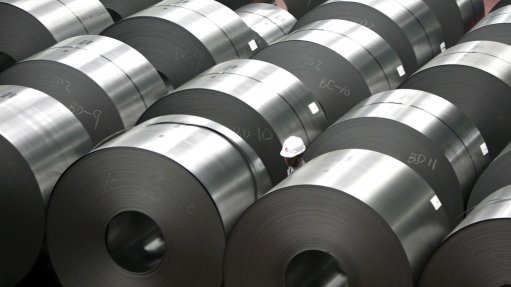
Photo by: Bloomberg
Research agency BMI expects steel prices to improve from current levels in coming months and maintains its 2024 global average steel price forecast of $740/t.
The average steel price is, however, expected to decrease again to $730/t, $700/t and $650/t in the next three years, respectively.
The steel price has averaged $698/t in the year-to-date and remains sensitive to stimulus announcements from Mainland China.
Although the global economic outlook remains bleak at the moment, with the manufacturing sector continuing to hinder growth in developed markets, BMI says China’s exports and domestic consumption growth from the automotive sector will support steel prices, as will India’s continued demand strength.
This while the Chinese property sector continues to grapple with challenges, including investment in the real estate sector having declined by 9.6% year-on-year in 2023.
However, weak demand from the property sector could be offset by growth in the automotive sector as yearly vehicle production in China is poised to grow by 2.8% year-on-year this year after having increased by 7% year-on-year in 2023.
The ongoing conflict in Ukraine will impact the economic outlook of the European Union and place strain on steel demand, while steel demand is also under pressure in the US owing to high interest rates and material costs, the agency points out.
On the supply side, BMI forecasts a modest 2% year-on-year increase in steel production this year, against the backdrop of a weak global economy, with downside risks persisting.
According to the World Steel Association, global crude steel production stabilised at 1.88-billion tonnes in 2023, after having declined in 2022. While crude steel production continues to grow in the major producing countries such as India and Russia, output in other key markets such as Japan, Germany Türkiye and Brazil contracted in 2023.
Beyond this year, global steel prices will trend downward and highlight the start of a paradigm shift in the steel market where ‘green’ steel produced with electric arc furnaces takes centre stage at the expense of traditional steel produced in blast furnaces.
Ultimately, BMI expects a combination of slowing Chinese steel consumption growth and rising global steel market protectionism, which is prompting greater production in affected countries, to loosen the market and drag prices lower in the medium term.
Chinese domestic demand for steel will continue to slow overall in the coming decade compared with the last as the rebalancing of the economy away from heavy industry and towards the service sector resumes in the wake of the collapse of the property market bubble, which will drag down domestic steel prices in China, as well as the global average.
Stronger demand growth in India and, possibly other emerging markets, is unlikely to offset the net effect of a China slowdown.
A stronger recovery in China’s property sector will be the major influencer driving demand and supporting steel prices, particularly if the market were to announce large stimulus policies.
On the downside, steel prices could head even lower if China’s economic momentum remains weak and if a deep recession in the US results in US steel prices collapsing.